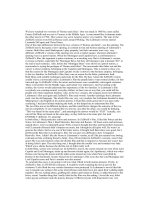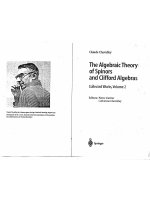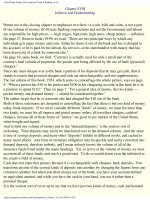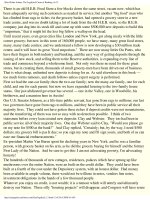the basic tenets of realism and naturalism
Bạn đang xem bản rút gọn của tài liệu. Xem và tải ngay bản đầy đủ của tài liệu tại đây (33.35 KB, 2 trang )
Throughout the history of theatre there have been many schools and styles. Theatre is ever
changing as a reflection of society and what society wants. But out of all these styles, there are
two which, when blended, produce a type of theatre that can always live and flow with society and
not drastically alter to fit in with the world's ever changing ways. These are Realism and
Naturalism. When combined, they form a powerful, truthful and powerfully real theatre. The two
men who have best managed to best combine these two elements are Konstantin Stanislavski with
his "system," and Anton Chekov with his dramatic writings and specifically, with his work in The
Cherry Orchard
The main beliefs of Realism and Naturalism are that the theatre needs to shun melodrama and
spectacle and, instead, present something that is real and true to life. They believe that the most
influential factors in a person's life are heredity and environment, and they feel that the characters
shown need to be more that two dimensional stock characters. They need to have real motives and
emotions and possess all the complexities that go into making a true personality and a true person.
Naturalists feel that plays should not be written in any sort of dramatic sequence or structure
because that is not true to life. Realists embrace the desire for reality on stage, but also feel that
dramatic structure follows the actual structure of life and structure and poetry should be integral
parts of drama.
Konstantin Stanislavski felt that same need for reality on the stage. He spent the majority of his
life searching for how an actor can create truth on stage and, in doing so, he tapped into many of
the same veins of humanity that Naturalists and Realists did. He expressed the same desire of
Naturalists for a realistic theatre that shows life with its dramatic structure and intrigue. ". . . I was
beginning to look for genuine life in [the theatre], not ordinary life, of course, but artistic life"
(Bentley, 220). And he went looking for it the same way that realists and naturalists did. He
began to look for a natural order for things and to devise a systematic plan from that natural base.
He went looking for truth. And, again, he found it in the same place as the Naturalists and realists
did. He found that, for an actor to bring full life to a character and full reality to the stage, he must
both create a character with a real soul, and he must not rely on stage tricks to do so. "An actor,
[Stanislavski] thought, must have some sort of spiritual preparation before the beginning of a
performance. Not only his body, but also his spirit must put on new clothes" (222). This type of
acting blends perfectly with realistic drama, which contains characters whose souls are inherent to
the script. He did not, however, feel that he was subscribing to either school of thought. He
stated that he felt that realism and naturalism were not things that needed to be pushed onto the
stage, but when a good actor takes on the role and fully builds his character from the inside out
and truly lives the reality of the stage, reality will flow from it with out outside help. "As soon as
[the realism] is justified, it becomes either unnecessary or it is not noticed at all . . ." (229).
Stanislavski embraced the same ideas of the Realist and Naturalist thinkers, but he didn't place the
emphasis on them. Instead, he felt they would emerge as soon as the actor fully filled the role.
And no one wrote better roles for this approach to theatre that Anton Chekov. Chekov was able to
write plays that embodied the idea of true, artistic life, and The Cherry Orchard is a shining
example of that. He takes a moment that has dramatic appeal and is emotionally charged, and
recreates it in a way that is true to life and yet exaggerated at the same time. He creates a reality
that is so real, it almost appears fake. However, it is this style of drama that is a perfect vehicle
for Stanislavski's system of acting. As Barrault says in his essay "Why The Cherry Orchard?."
"The Cherry Orchard is one of the few plays in which a whole cast could really get so profoundly
lost as to cease to believe that they are in a theatre, and believe on the contrary that this family
truly exists and that they are in real life . . ." That was Stanislavski's goal for his actors. That was
the ultimate peak to reach. So why is this not Naturalism if the actors create a full reality? Also,
he creates this complete reality, yet it is a reality steeped in poetry and lyric. So why is it not
Realism if he creates truth through poetry? As Barrault says, "This play belongs neither to the
naturalism of the beginning of the century nor to realism, it belongs to truth, and truth always has
two faces, a real one, and a poetic one."
And that is the true form that theatre should take. It doesn't have to be one way or the other, as the
Realists and the Naturalists seem to think. True reality is a blend of both. And Chekov was the
master of that form. He so cleanly blended the two ideas that it is impossible to separate them into
separate places. And through this masterpiece of dramatic writing, Stanislavski's systematic
method of creating truth can have a fighting chance at reaching the heights that it is capable of. So
it is that through a mixture of the two schools of thought and the work of the two men who have
mastered it that theatre can reach a point of beauty and truth and can display reality and drama in a
way that doesn't need to adapt with the changes of life because it is based in life. The theatre that
emerges from this blend has its roots deep in the heart of humanity and what people truly want,
and, consequently, will never die.









